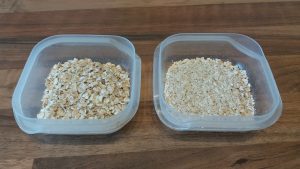The difference between regular porridge oats and instant oats in a sachet might not be immediately obvious to you. In fact, when you look at the ingredients, both will say something like “100% Wholegrain Rolled Oats”.

The only difference is in the size of the flakes. As should be immediately obvious from the picture above, the instant oats are ground into finer flakes, almost like a powder. This allows them to cook marginally quicker, at least from my experience. From pouring boiling water on them the instant oats take about 40 seconds to be ready, with the regular oats at about 60 seconds. So what else is different?

Source: valeriecurrie.com
If you’re familiar with GI, the Glycaemic Index, it’s the ability of a carbohydrate containing food to raise your blood glucose levels, relative to pure glucose, which scores 100. As you can see above, Rolled Oats and Oatmeal are Low GI foods, scoring 50 and 55 respectively. Instant Oatmeal on the other hand is a High GI food, scoring a whopping 83! Well, what difference does that actually make?

I measured my Post-Prandial Glucose Response, more simply what my (non-diabetic) blood sugar levels did after eating the same portion of each type of oats, and here’s what I saw. Rolled oats had a very stable rise and fall, levelling out around 4.5mmol/L (81mg/dL), which is my fasted level. The instant oats had a much higher spike, reaching 7.5mmol/L (135mg/dL) at 30 minutes, before dropping sharply, something associated with feelings of hunger soon after eating.
This is particularly important for sufferers of diabetes, who have to keep their blood sugar levels in check, but for the general population it might also be better to start your day with rolled oats. While the sachets are no doubt more convenient to some, the trade off is a much more aggressive rise in blood sugar levels and possibly feeling hungry well before lunch time.

